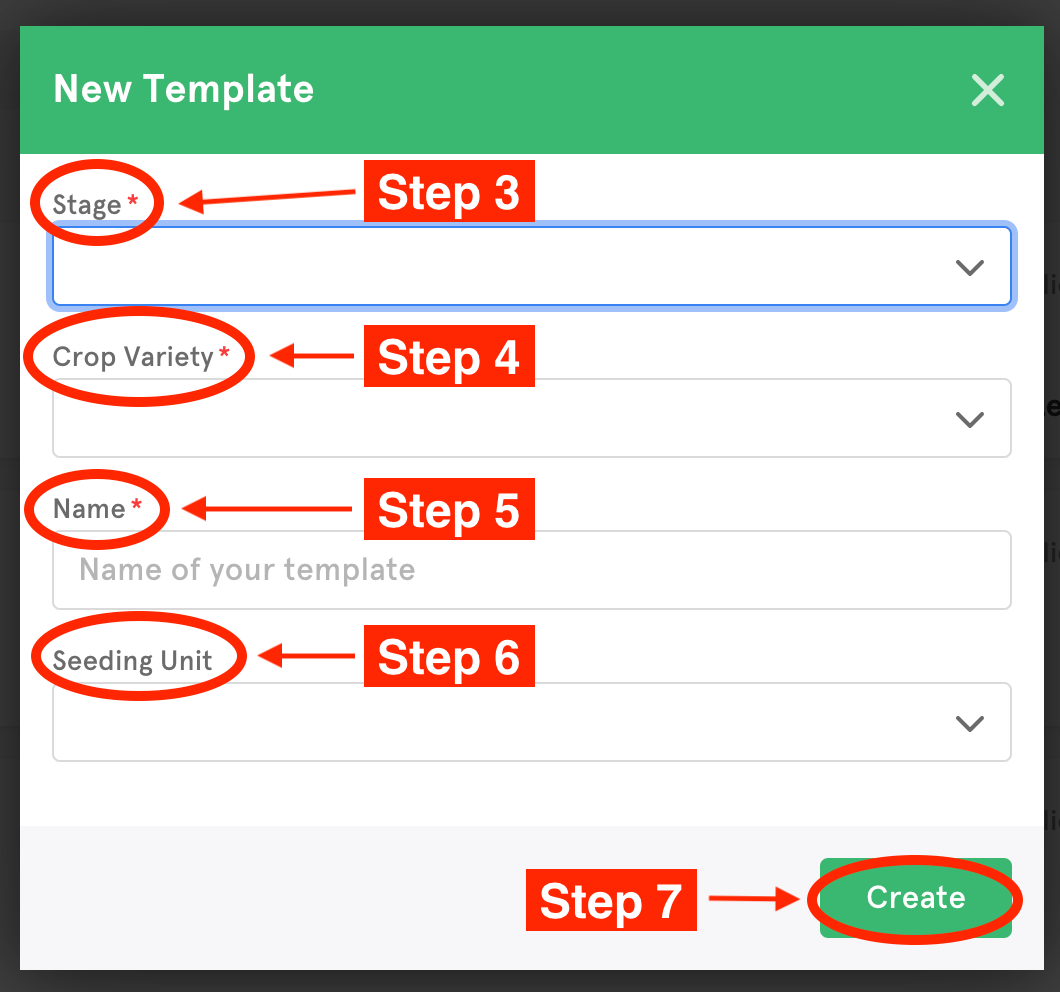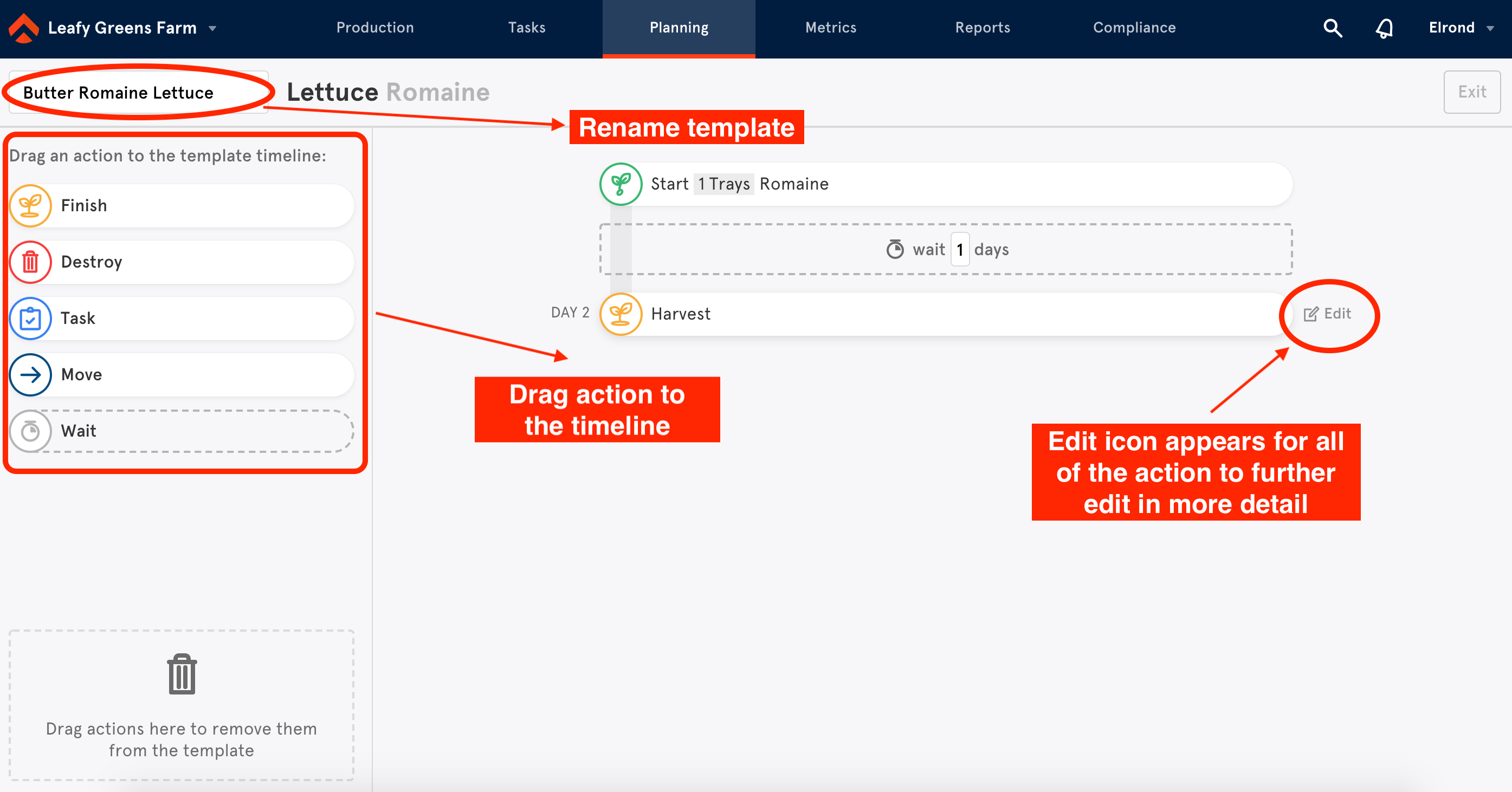Templates are LUNA CMP's system for planning crops cycles. By creating templates, users can set up their ideal timeline to describe how their crop will move through their facility from seed to harvest.
The following items will need to be set up and defined in your Settings beforehand in order to then create a template and start batches:
-A Variety and its corresponding Resource Units
-Any relevant Batch Units
-Any relevant Zones
You can refer to this general "Getting Started" article for overview definitions each of these items.
To create a Multi-Step Template:
Step 1: Click on the Planning tab in the menu bar
Step 2: Click on the green + Add Template button on the upper right-hand corner

Step 3: Select the Stage* where you would like to create the template from the drop down list (Crops, Packing, Shipping, Materials)
Step 4: Select the Crop Variety* from the drop down list
Step 5: Name* your template
Step 6: Select your Seeding Unit (also called a Batch Unit).
Step 7: Click on the green Create button on the bottom right corner to create your template

After creating your new template, a new builder page will appear to finish creating your template. You will be able to rename the template name at any point using the text box in the upper left corner.

- By default, the first action will be a Start task and the last will be a Harvest (or Finish) task. Add additional actions to the template by dragging and dropping selected action from the left sidebar into the timeline.
- The Seeding Unit/Batch Unit & Zone should always be defined on the Start task. If it is not defined in the template, users will be required to define them when starting a batch.
- To remove items from the body of the template, simply drag them over to the lower left corner of the page and drop them into the trash can icon.
- Click the Edit icon on the right side of the action to adjust the name of a manual task, repetition, quantities, labor requirements, instructions, inputs, outputs, etc.
- Once the template have been set up, click Save. Exit will take you back to the Template Planning screen.
Common Template Terms in the template editor:
Edit: By clicking the Edit button for to the right of any action, the parameters for that specific action can be adjusted.
Delete: To delete an action previously added to the template timeline, drag it to the trash can icon in the bottom left-hand corner. Note that Start tasks cannot be removed from the timeline.
Discard: Discard actions represent clearing out all or part of the crop inventory due to a number of reasons, including disease, slow growth, and more. Discarding a portion or all of a batch will adjust the current quantity and well as the forecasted amount.
Harvest/Finish: Harvest actions are the harvests being performed, whether Complete, Partial, or Cut and Come Again.
- Complete harvests will represent the end of a batch and you're removing the product from the active growth stage.
- Partial harvests represent removing part of the quantity of the product from the active growing process while allowing some remaining quantity to continue to grow.
- Cut and Come Again represent a continual harvest where you harvest the ripe fruit or product and let the plant continue to grow. This is common with vine crops and herbs.
Move: Move actions represent moving a crop from one zone or stage to another. You can define all fields on the move action ahead of time or leave blank and determine them as you move the batch.
Task: Task actions represent other manual tasks, such as “Clean Drain” or “Trim Leaves,” that may apply to the crop.
Wait: Wait days represent the number of days between the current task and the start of the previous task. Define Wait actions between each of the actions to space them out according to the crop’s schedule.
-
On the right side of the timeline, the wait days will display how many days between the start of each action.
-
On the left side of the timeline, the day that the specific action is set to start will be displayed.
Setting Inputs and Outputs:
Using resources, you can set inputs and outputs on each template. This will help with traceability and tying batches together.
On Inputs, you'll set the quantity to consume based on the batch unit quantity, the resource being consumed, and the type of consumption:
- Manual: you'll select the batch from which to draw each time
- FIFO (First In, First Out): the oldest batch on hand for that input will automatically be used
- LIFO (Last In, First Out): the newest batch on hand for that input will automatically be used
On Outputs, you'll set the quantity to be generated and the resource being generated. If you don't know the quantity that will be generated, you can leave the field blank. The user will always confirm the amount being generated when they check off the respective task on the batch.
Click here to learn more about creating resources.
One-Step Templates:
For batches that do not require tracking multiple steps (e.g. Material lots being checked into inventory, simple Packing or Shipping batches) you can now create a One-Step Template that is both a Start and Finish task in one. Please refer to this article for the steps to take to set one up.
NOTE:
Duplicating Templates to new Varieties will create new Resource Units under that Variety, should there be no existing Resource Units that match the ones set as inputs or outputs on the Template being duplicated. We suggest following one of these processes when adding new Varieties and Templates:
1.
-Add a new Variety
-Duplicate a Template that has Resource Units set as inputs/outputs similar to the ones you'd like to create
-Go to Settings and adjust the newly created Resource Units if/as required
OR
2.
-Add a new Variety
-Manually add the Resource Units desired under the new Variety
-Duplicate a Template that does not have inputs/outputs set
-Manually set the Resource units as inputs and outputs
OR
3.
-Add a new Variety
-Manually add the Resource Units desired under the new Variety
-Duplicate a Template that has matching Resource Units set as inputs/outputs (where the four Resource Unit fields – Type, Unit, Additional Info, and Decimals – are exactly the same)
> So long as they match all four fields on both Varieties, this process should pull in the existing Resource Units and not create new ones.

Comments
0 comments
Please sign in to leave a comment.